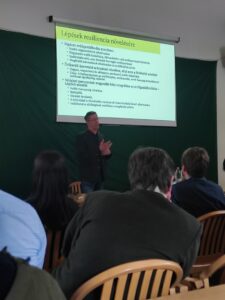The workshop Climate Friendly Forest Management in Hungarian Forests was held on March 30, 2023, as part of the CLIMAFORCEELIFE’s Climate-Smart Forest Management in Central and Eastern Europe project, jointly organized by WWF Hungary and the Association of Hungarian Private Forest Owners (MEGOSZ). With their presentations, public and private forest managers, researchers, representatives of the nature conservation sector, and even public officials of forest management helped to raise professional standards in order to examine from different perspectives the challenges of climate change and possible responses to it.
The workshop’s presenters provided various examples of the difficulties caused by climate change as well as potential solutions. Participants agreed that diversifying our forests is necessary to create resilient stands that can endure the increasingly difficult effects of the changing environment. Our forests’ increased genetic and structural diversity both contribute to their adaptation and resilience.
During the event, private forestry partners of the CLIMAFORCEELIFE project gave presentations about their own techniques and urged other foresters to collaborate. On the project website, under the Project results section, you can find all of the climate adaption plans that they prepared.
In his keynote speech, László Gálhidy, the coordinator of WWF Hungary’s forest programme, went over the dangers and effects of climate change on forests. After asking the question – How can we influence how systems adapt to change? – he discussed the research done in Slovakia and Romania as part of the project’s preparatory phase. He emphasised that active interventions, which can help the forest ecosystem’s adaptability and subsistence, are going to be essential. He gave continuous forest cover management as an example of possible management alternative.
Attila Borovics, the Director of General of the Hungarian Forest Research Institute, addressed the effects of climate change that are already being seen in his presentation, which included decreased production and rising mortality. He elaborated on the unprecedented rapidity of climate change, which cannot be matched by natural species migration. He used oak as an example, where spontaneous migration happened at a rate of 5–50 km/100 years following the last ice age. With the projected temperature rise, a speed of 250-500 km per 100 years would be required, which he says is impossible without human help.. We can also rely on pollen from the south to update the gene pool, but in addition, according to him, blending with imported propagating material can be a very effective strategy for our forest stands to successfully adapt to the changing climate. This requires knowing the precise coordinate level of the growing areas in northern Bulgaria and southern Romania. He then discussed how forests may play a bigger part in climate change mitigation: he sees more room for innovation in the timber industry, for example, in the carbon-retention capability of wood-based products developed through new processing methods.
Péter Csépányi, Deputy Director General of Pilisi Parkerdő Zrt., presented on climate change-related damage events and the Hungarian state forestry’s response to them. He explained how the effects of climate change are leading to an increase in biotic and abiotic damage events. According to damage reports for 2021, annual forest damage is 109 422 ha, with 79% being biotic (86 114 ha), 81% being caused by insects, 12% by vertebrates, and 21% being caused by abiotic forces. The frequency of extreme weather phenomena is increasing. Drought damage was responsible for 59.5% of all abiotic damage. Extreme weather events are a problem, but so are persistent winter frosts and lack of snow. Ice damage is considerable in unmixed, even-aged stands but not in mixed-age and structure stands, indicating that more natural forests are more resistant to ice damage. He discussed the potential of forests to defend and regulate themselves (including their stability, resilience, and ability to mitigate the impact of extreme events, and relationship to diversity). Following that, he discussed silvicultural strategies that can help build resilience, then provided real-world examples based on his own experience, including the possibilities of application of continuous cover forest management.
The Kiskunság National Park Directorate’s deputy director general, Ferenc Sipos, gave a presentation on the effects of climate change on the forests in the Danube-Tisza region and how the park is addressing them. The forest cover in the territory of their Directorate is significantly fragmented as a result of the processes and anthropogenic impacts in the forest steppe areas. Forest types, that require more water, are already changing due to climate change into more drought-tolerant stands. Droughts are occurring more frequently, which is limiting the ability of native tree species to reproduce from seed. There is a perceived lack of continuous winter frosts, a loss of snow cover, the expansion of frost-sensitive exotic species, and an increase in insect problems. By recovering steppe forests, supporting natural processes, and assisting pest predators, negative impacts are being reduced. They tolerate the barrier reduction due to natural reasons as well as striving for continual forest cover.
After the workshop’s presentations, the participants engaged in a technical discussion. Participants summarized that the mixed use of continuous cover forestry and even aged forestry methods, adapted to the specific habitats, can lead to the achievement of social, economic and conservation objectives… It was said that climate change was not a factor in the decision to switch to continuous cover forestry in the state forestry sector.
There was agreement on the value of indigenous reproducing material, however it was noted that it can be challenging to find safe reproducing material and that there are regulatory issues related to this. The difficulty of obtaining safe propagating material was mentioned, as well as the regulatory problems associated with this, but there was consensus on the importance of the priority of the indigenous propagating material. The risks of species from outside of Europe invading the continent were also highlighted by contributors.
Private forest owners and farmers, according to József Duska, executive president of the Association of Hungarian Private Forest Owners, have a part to play in preserving the climate and slowing the rate of climate change.. By planting new forests and properly maintaining and restoring existing ones, they can contribute to slowing down climate change. Water retention, and establishment of diverse, structured forests are crucial for climate adaptation. He emphasized the issues caused by the disadvantageous ownership of private forest holdings, which significantly restricts the options for managing forests. He claimed that since the 1990s, subsidies and profits have played a very prominent role in influencing private forest management practices because the main objective of private forest owners and farmers is to make a profit. It proposes modifications to administrative practices and quicker procedures to aid farmers’ activities.
The Rural Development Program’s forestry entitlements related to climate change and climate adaptation, such as the preservation and advancement of forest genetic resources or forest-environment payments, were presented by Sándor Szentpéteri, Head of the Forestry Development Policy and Innovation of the Ministry of Agriculture. He explained that the CAP (Common Agricultural Policy, the European Union’s (EU) agricultural support system) strategy will use a new nomenclature beginning in 2023, with interventions replacing titles and categories such as investment and cooperation replacing named forest interventions. Whether public or private individuals are involved, a results-based approach will be the yardstick for EU objectives, with the same level of support for the results achieved. The establishment of more and better forests through more competitive forest management is one of the sector’s development policy objectives. Knowledge expansion and transfer, along with instruments like consulting, advanced training, and innovative partnership, is another general goal.
Private forest manager, Péter Laczkó from Zemplén region plans his forestry treatments to raise the capacity of his forests to adapt to changing climates. Forests managed with continuous forest cover are more resistant to abiotic agents, according to his experience. Long-term plans call for the current stand of 8 tree species in the sample area to be changed into a mixed stand of 10 to 12 species, which will foster stem regeneration and the formation of canopy levels of two and three. The timing of timber harvesting, with a return every 3-5 years, is chosen to minimise soil erosion and thus protect soil biota.. The area surrounding his forest’s watercourses is a sparing area. With the use of dead wood in watercourses, they help to slow down and retain water, which helps to maintain a more favourable water balance . The primary issue that he faces is the damaging effects of big game, which he principally defends against via fencing.
Gábor Flamich manages his forests in the Danube Bend region, with the main goal of conversion these forests to continuous cover management. He perceives the water retention as one of the fundamental defences against climatic extremes including winter, spring, and summer droughts, and as an essential component of the forest microclimate. In order to achieve this, he works to slow down run-off in forest gullets and to boost the water retention capacity of ponds and wallows. He intends to replace the pine in his forests to achieve increased resilience with indigenous species.
Tamás Frank, a forester from Bátor (Mátra region), has to organize his farming operations in a number of ways. He must consider the droughts that are occurring more frequently, the challenging growth circumstances, and the weak resilience of the homogenous scots pine and black pine plantations. Overpopulation of game damages his forest with a significant edge effect, which he attempts to prevent by fencing in buffers and strengthening the shrub layer of the forest edge. By establishing microhabitats and fostering insectivores through small-scale tree stand restructuring, and introduction of indigenous species, he is attempting to make his forest more resilient.
The workshop demonstrated how the views of forest management and nature protection are converging. The majority of participants felt that maintaining and managing forests with a varied, variable age-classes structural diversity of native tree species is one of the primary approaches to preserve and develop resilience to climate change. More events with comparable exchanges were requested by the participants. They emphasized the significance of improving management and conservation methods through research, observations, surveys, and effective information exchange.
On the project website, under the Project results section, you can find all of the climate adaptation plans (in Hungarian) that the partner foresters of the CLIMAFORCEELIFE project put together.
The presentations of the speakers (in Hungarian) can be downloaded by clicking on the link below: https://t.ly/i8O6
Photo: Pál Bódis











